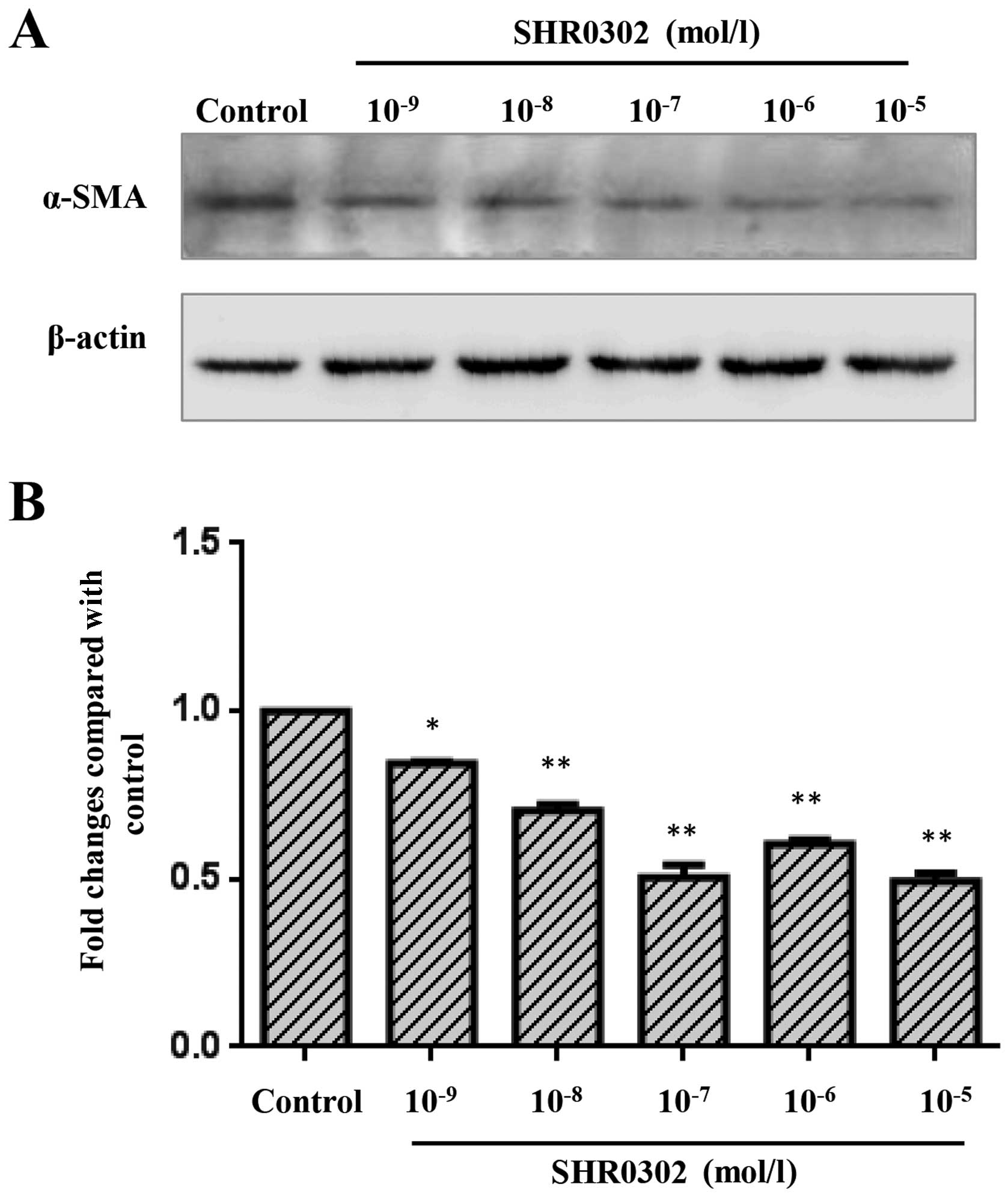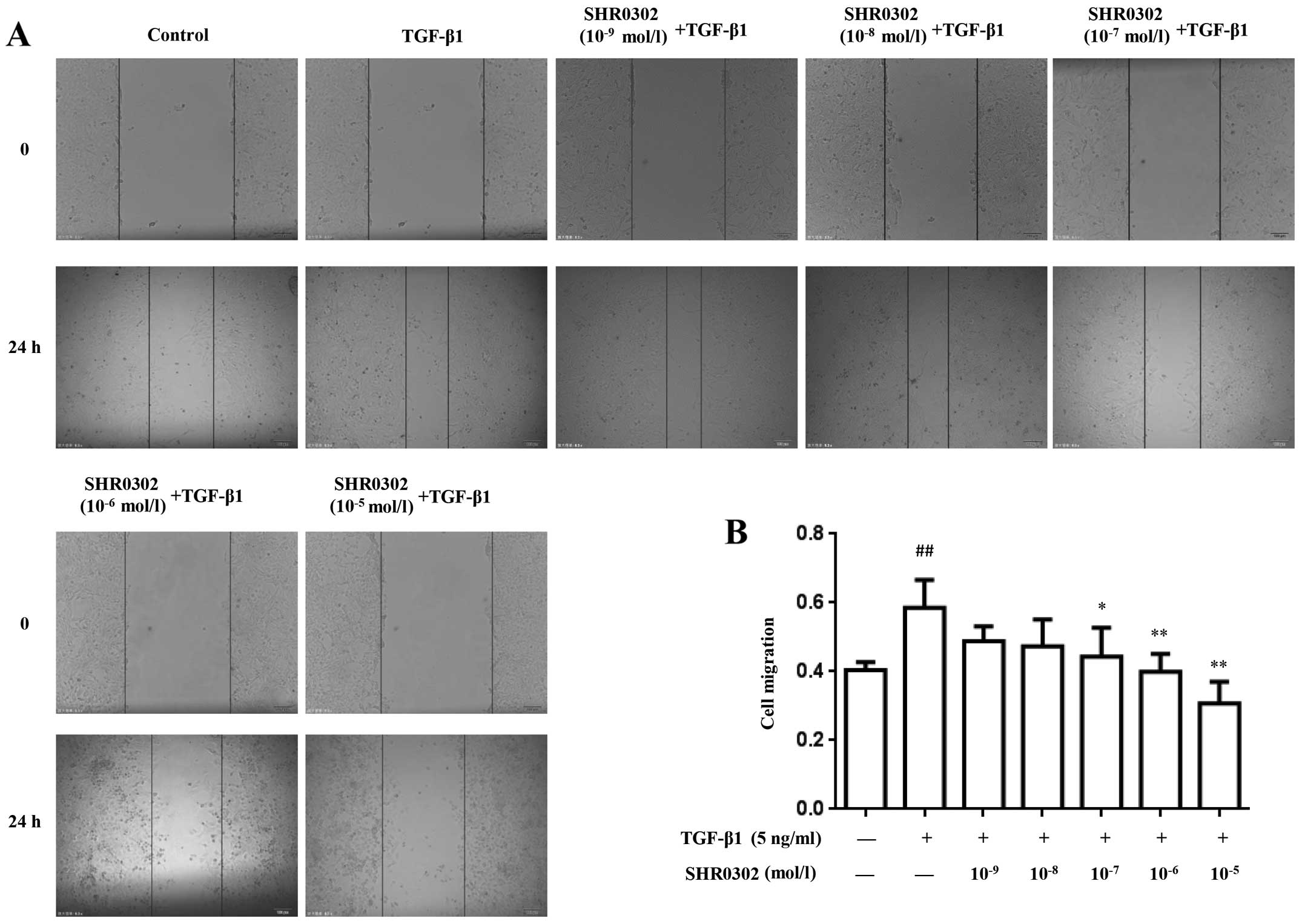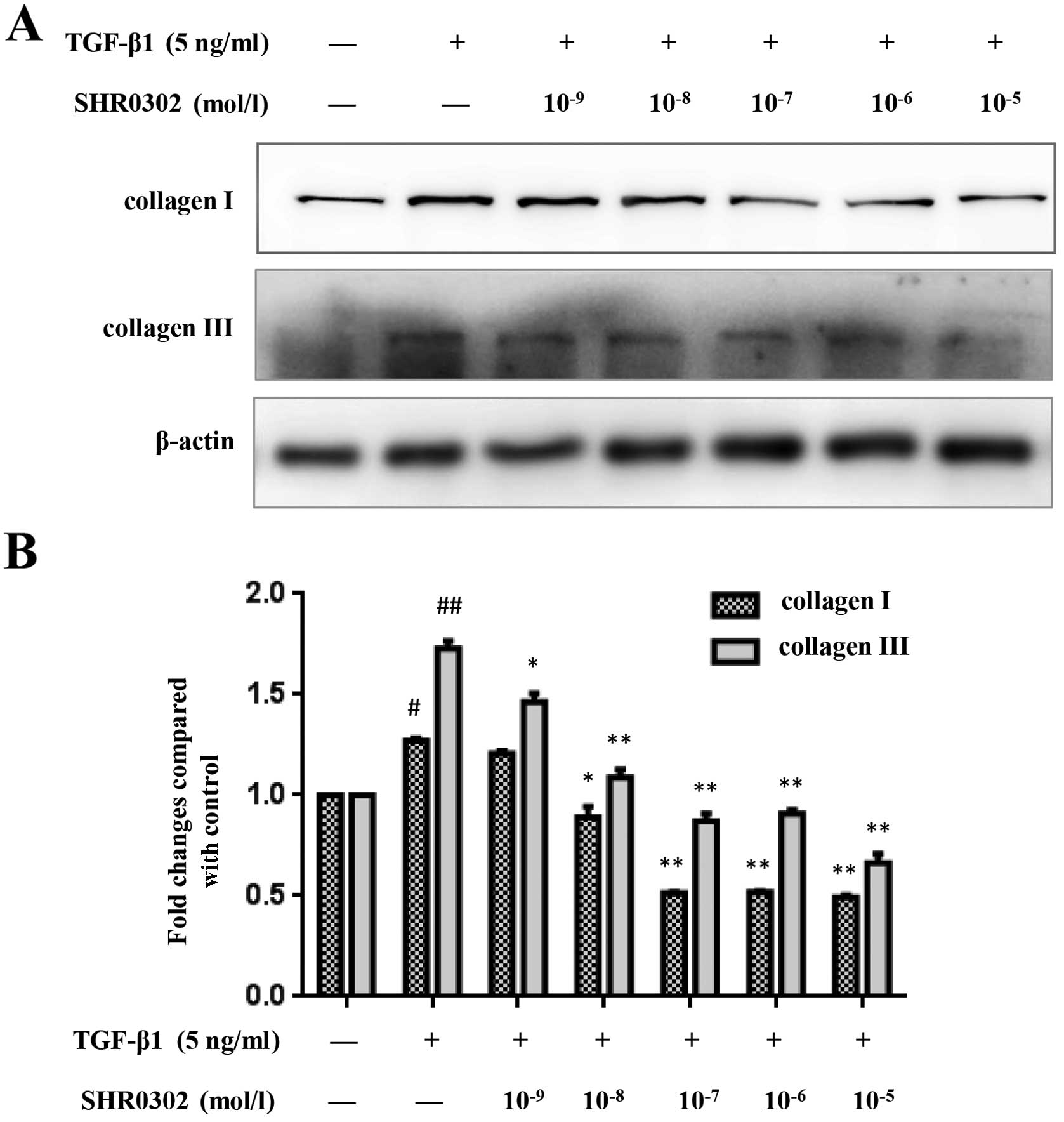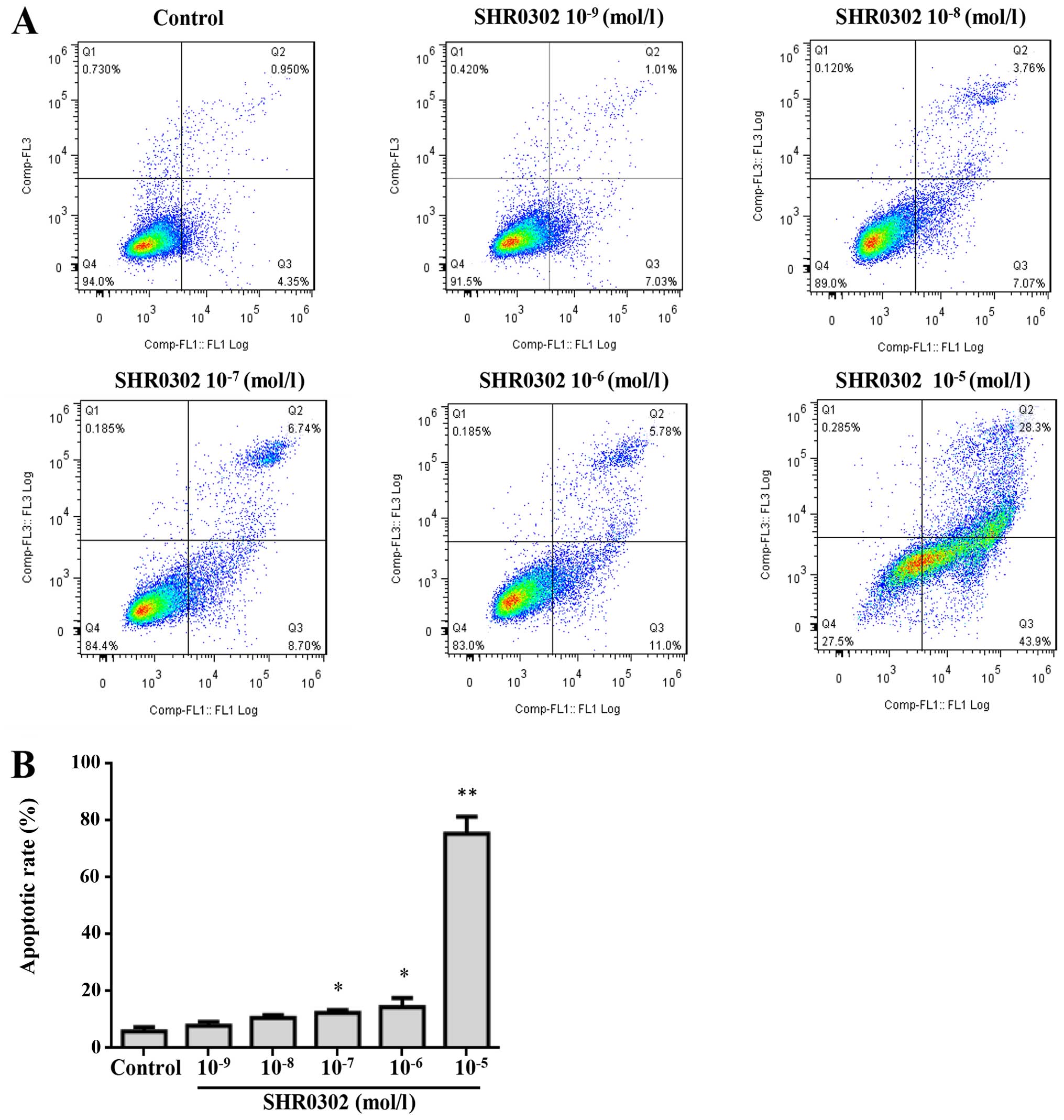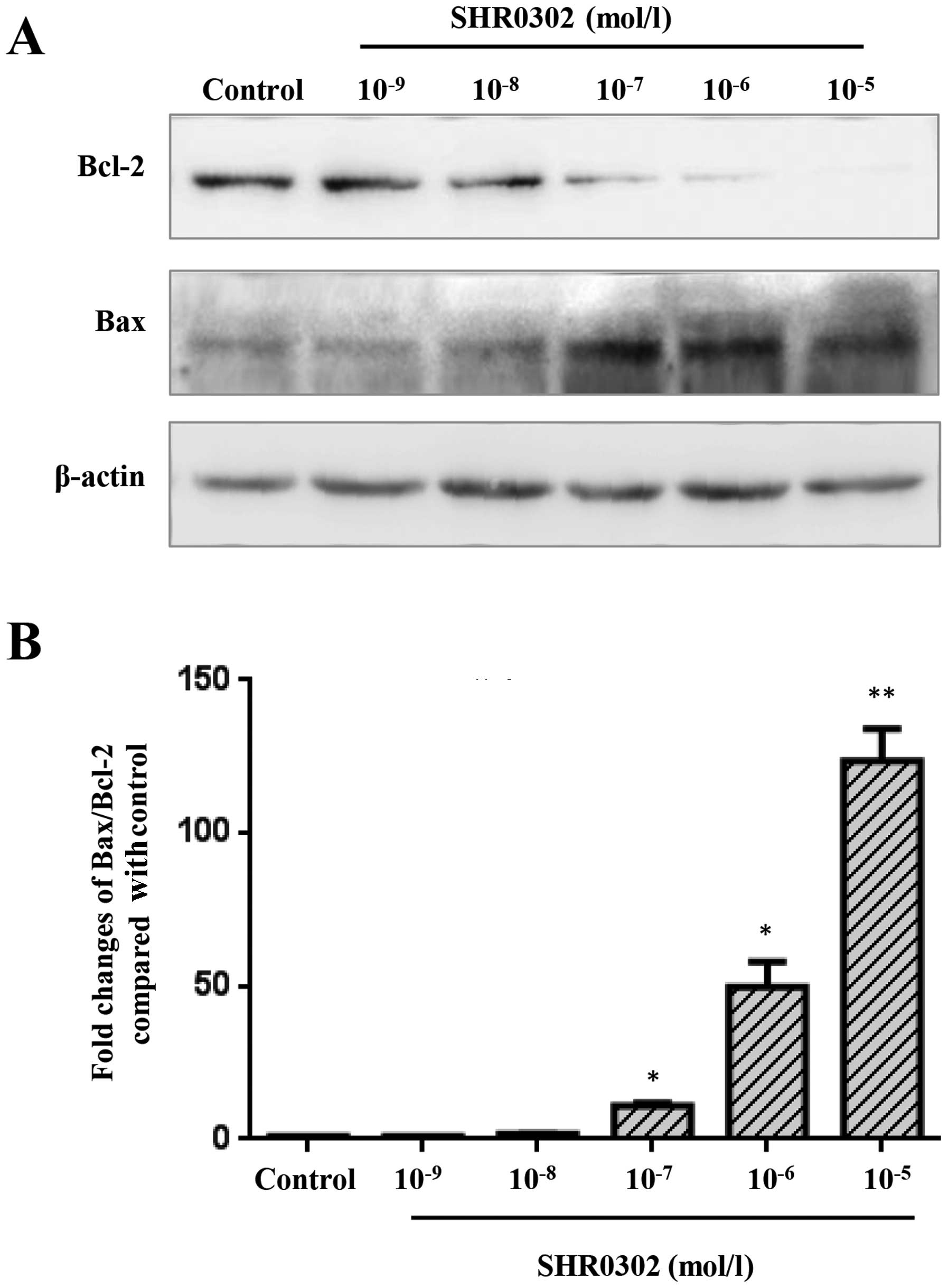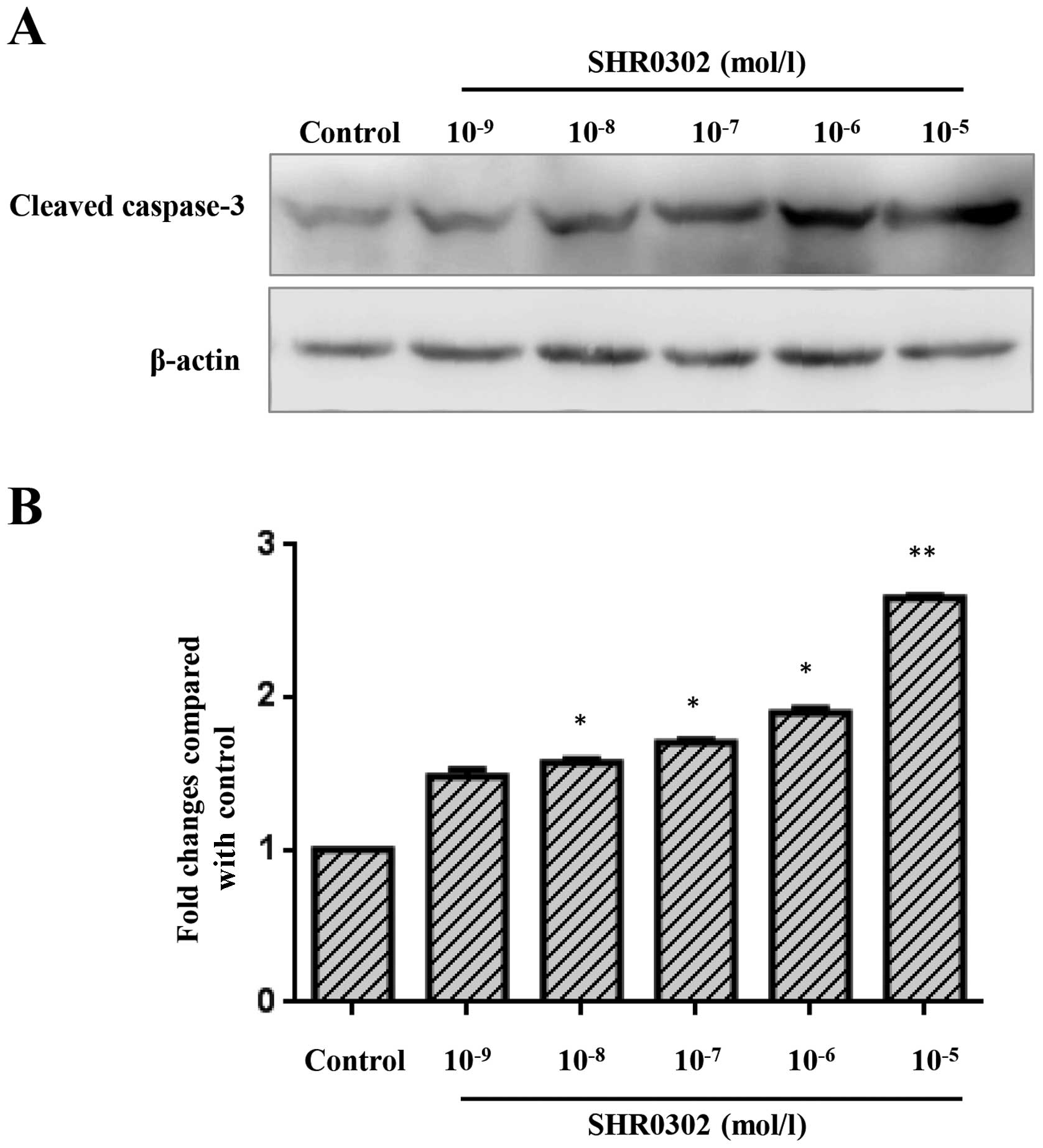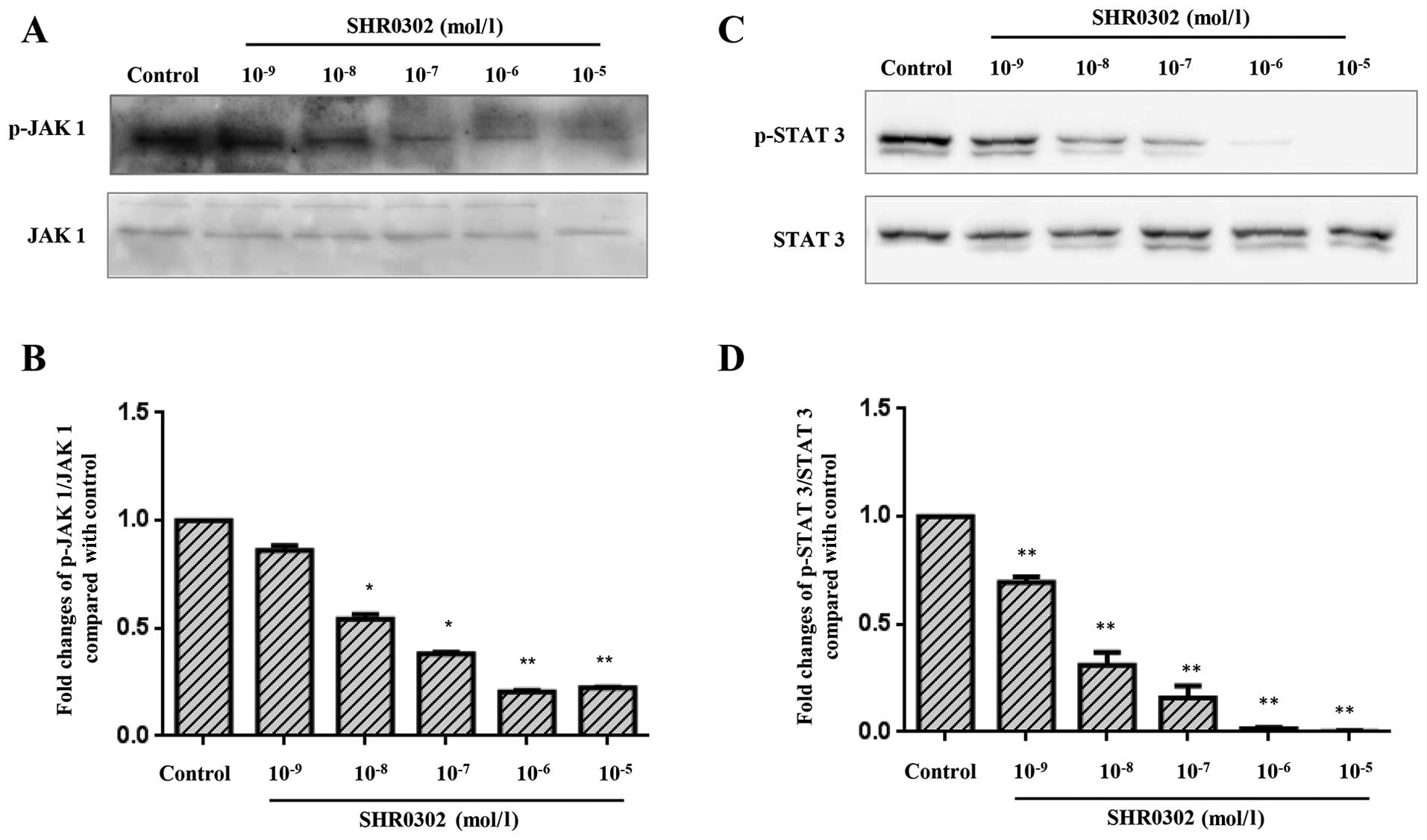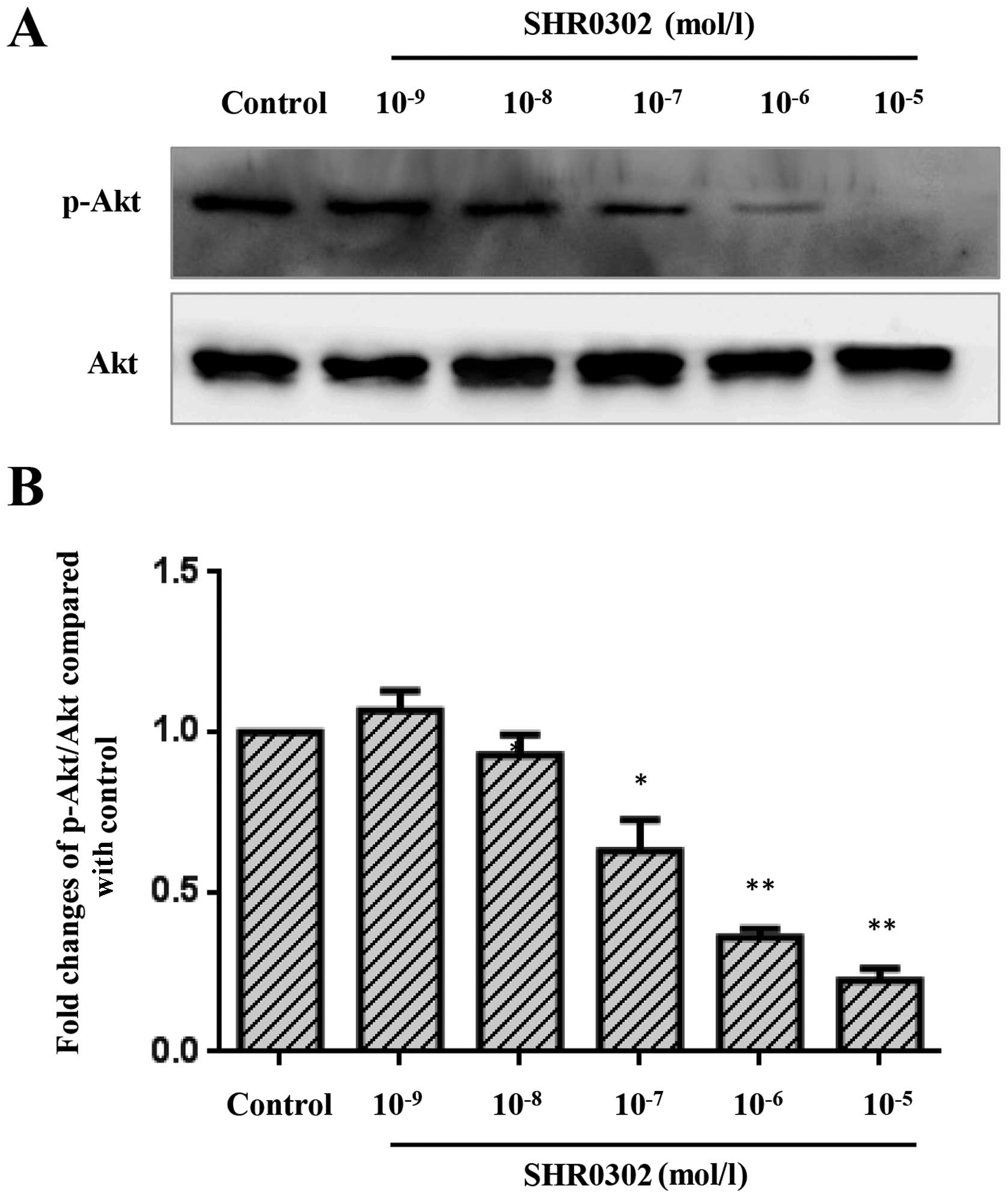|
1
|
Leon DA and McCambridge J: Liver cirrhosis
mortality rates in Britain from 1950 to 2002: an analysis of
routine data. Lancet. 367:52–56. 2006. View Article : Google Scholar : PubMed/NCBI
|
|
2
|
Priya S and Sudhakaran PR: Cell survival,
activation and apoptosis of hepatic stellate cells: modulation by
extracellular matrix proteins. Hepatol Res. 38:1221–1232.
2008.PubMed/NCBI
|
|
3
|
Wang P, Liu T, Cong M, Wu X, Bai Y, Yin C,
An W, Wang B, Jia J and You H: Expression of extracellular matrix
genes in cultured hepatic oval cells: an origin of hepatic stellate
cells through transforming growth factor beta? Liver Int.
29:575–584. 2009. View Article : Google Scholar : PubMed/NCBI
|
|
4
|
Moles A, Tarrats N, Morales A, Domínguez
M, Bataller R, Caballería J, García-Ruiz C, Fernández-Checa JC and
Marí M: Acidic sphingomyelinase controls hepatic stellate cell
activation and in vivo liver fibrogenesis. Am J Pathol.
177:1214–1224. 2010. View Article : Google Scholar : PubMed/NCBI
|
|
5
|
Fallowfield JA: Therapeutic targets in
liver fibrosis. Am J Physiol Gastrointest Liver Physiol.
300:G709–G715. 2011. View Article : Google Scholar : PubMed/NCBI
|
|
6
|
Povero D, Busletta C, Novo E, di Bonzo LV,
Cannito S, Paternostro C and Parola M: Liver fibrosis: a dynamic
and potentially reversible process. Histol Histopathol.
25:1075–1091. 2010.PubMed/NCBI
|
|
7
|
Seavey MM and Dobrzanski P: The many faces
of Janus kinase. Biochem Pharmacol. 83:1136–1145. 2012. View Article : Google Scholar : PubMed/NCBI
|
|
8
|
Tanaka Y: Recent progress and perspective
in JAK inhibitors for rheumatoid arthritis: from bench to bedside.
J Biochem. 158:173–179. 2015. View Article : Google Scholar : PubMed/NCBI
|
|
9
|
Kisseleva T, Bhattacharya S, Braunstein J
and Schindler CW: Signaling through the JAK/STAT pathway, recent
advances and future challenges. Gene. 285:1–24. 2002. View Article : Google Scholar : PubMed/NCBI
|
|
10
|
Pardanani A, Vannucchi AM, Passamonti F,
Cervantes F, Barbui T and Tefferi A: JAK inhibitor therapy for
myelofibrosis: critical assessment of value and limitations.
Leukemia. 25:218–225. 2011. View Article : Google Scholar
|
|
11
|
Johnson SJ, Hines JE and Burt AD:
Phenotypic modulation of perisinusoidal cells following acute liver
injury: a quantitative analysis. Int J Exp Pathol. 73:765–772.
1992.PubMed/NCBI
|
|
12
|
Cheng K, Yang N and Mahato RI: TGF-beta1
gene silencing for treating liver fibrosis. Mol Pharm. 6:772–779.
2009. View Article : Google Scholar : PubMed/NCBI
|
|
13
|
Kanzler S, Lohse AW, Keil A, Henninger J,
Dienes HP, Schirmacher P, Rose-John S, zum Büschenfelde KH and
Blessing M: TGF-beta1 in liver fibrosis: an inducible transgenic
mouse model to study liver fibrogenesis. Am J Physiol.
276:G1059–G1068. 1999.PubMed/NCBI
|
|
14
|
Mair M, Blaas L, Österreicher CH, Casanova
E and Eferl R: JAK-STAT signaling in hepatic fibrosis. Front Biosci
(Landmark Ed). 16:2794–2811. 2011. View
Article : Google Scholar
|
|
15
|
Paik YH, Kim JK, Lee JI, Kang SH, Kim DY,
An SH, Lee SJ, Lee DK, Han KH, Chon CY, et al: Celecoxib induces
hepatic stellate cell apoptosis through inhibition of Akt
activation and suppresses hepatic fibrosis in rats. Gut.
58:1517–1527. 2009. View Article : Google Scholar : PubMed/NCBI
|
|
16
|
Son G, Hines IN, Lindquist J, Schrum LW
and Rippe RA: Inhibition of phosphatidylinositol 3-kinase signaling
in hepatic stellate cells blocks the progression of hepatic
fibrosis. Hepatology. 50:1512–1523. 2009. View Article : Google Scholar : PubMed/NCBI
|
|
17
|
Schuppan D and Kim YO: Evolving therapies
for liver fibrosis. J Clin Invest. 123:1887–1901. 2013. View Article : Google Scholar : PubMed/NCBI
|
|
18
|
Mallat A and Lotersztajn S: Cellular
mechanisms of tissue fibrosis. 5. Novel insights into liver
fibrosis. Am J Physiol Cell Physiol. 305:C789–C799. 2013.
View Article : Google Scholar : PubMed/NCBI
|
|
19
|
Senoo H, Yoshikawa K, Morii M, Miura M,
Imai K and Mezaki Y: Hepatic stellate cell (vitamin A-storing cell)
and its relative-past, present and future. Cell Biol Int.
34:1247–1272. 2010. View Article : Google Scholar : PubMed/NCBI
|
|
20
|
Hernandez-Gea V and Friedman SL:
Pathogenesis of liver fibrosis. Annu Rev Pathol. 6:425–456. 2011.
View Article : Google Scholar
|
|
21
|
Choi JH, Hwang YP, Choi CY, Chung YC and
Jeong HG: Anti-fibrotic effects of the anthocyanins isolated from
the purple-fleshed sweet potato on hepatic fibrosis induced by
dimethylnitrosamine administration in rats. Food Chem Toxicol.
48:3137–3143. 2010. View Article : Google Scholar : PubMed/NCBI
|
|
22
|
Clément S, Pascarella S, Conzelmann S,
Gonelle-Gispert C, Guilloux K and Negro F: The hepatitis C virus
core protein indirectly induces alpha-smooth muscle actin
expression in hepatic stellate cells via interleukin-8. J Hepatol.
52:635–643. 2010. View Article : Google Scholar : PubMed/NCBI
|
|
23
|
Wu J and Zern MA: Hepatic stellate cells:
a target for the treatment of liver fibrosis. J Gastroenterol.
35:665–672. 2000. View Article : Google Scholar : PubMed/NCBI
|
|
24
|
Pang M, Ma L, Gong R, Tolbert E, Mao H,
Ponnusamy M, Chin YE, Yan H, Dworkin LD and Zhuang S: A novel STAT3
inhibitor, S3I-201, attenuates renal interstitial fibroblast
activation and interstitial fibrosis in obstructive nephropathy.
Kidney Int. 78:257–268. 2010. View Article : Google Scholar : PubMed/NCBI
|
|
25
|
Yu Y, Wang Y, Niu Y, Fu L, Chin YE and Yu
C: Leukemia inhibitory factor attenuates renal fibrosis through
Stat3-miR-29c. Am J Physiol Renal Physiol. 309:F595–F603. 2015.
View Article : Google Scholar : PubMed/NCBI
|
|
26
|
Zhang W, Niu M, Yan K, Zhai X, Zhou Q,
Zhang L and Zhou Y: Stat3 pathway correlates with the roles of
leptin in mouse liver fibrosis and sterol regulatory element
binding protein-1c expression of rat hepatic stellate cells. Int J
Biochem Cell Biol. 45:736–744. 2013. View Article : Google Scholar : PubMed/NCBI
|
|
27
|
Ridley AJ, Schwartz MA, Burridge K, Firtel
RA, Ginsberg MH, Borisy G, Parsons JT and Horwitz AR: Cell
migration: integrating signals from front to back. Science.
302:1704–1709. 2003. View Article : Google Scholar : PubMed/NCBI
|
|
28
|
Michaud-Levesque J, Bousquet-Gagnon N and
Béliveau R: Quercetin abrogates IL-6/STAT3 signaling and inhibits
glioblastoma cell line growth and migration. Exp Cell Res.
318:925–935. 2012. View Article : Google Scholar : PubMed/NCBI
|
|
29
|
Lim CP, Phan TT, Lim IJ and Cao X: Stat3
contributes to keloid pathogenesis via promoting collagen
production, cell proliferation and migration. Oncogene.
25:5416–5425. 2006. View Article : Google Scholar : PubMed/NCBI
|
|
30
|
Schuppan D: Structure of the extracellular
matrix in normal and fibrotic liver: collagens and glycoproteins.
Semin Liver Dis. 10:1–10. 1990. View Article : Google Scholar : PubMed/NCBI
|
|
31
|
Rojkind M and Martinez-Palomo A: Increase
in type I and type III collagens in human alcoholic liver
cirrhosis. Proc Natl Acad Sci USA. 73:539–543. 1976. View Article : Google Scholar : PubMed/NCBI
|
|
32
|
Grimaud JA, Druguet M, Peyrol S, Chevalier
O, Herbage D and El Badrawy N: Collagen immunotyping in human
liver: light and electron microscope study. J Histochem Cytochem.
28:1145–1156. 1980. View Article : Google Scholar : PubMed/NCBI
|
|
33
|
Lakner AM, Moore CC, Gulledge AA and
Schrum LW: Daily genetic profiling indicates JAK/STAT signaling
promotes early hepatic stellate cell transdifferentiation. World J
Gastroenterol. 16:5047–5056. 2010. View Article : Google Scholar : PubMed/NCBI
|
|
34
|
Hellerbrand C, Stefanovic B, Giordano F,
Burchardt ER and Brenner DA: The role of TGFbeta1 in initiating
hepatic stellate cell activation in vivo. J Hepatol. 30:77–87.
1999. View Article : Google Scholar : PubMed/NCBI
|
|
35
|
Thompson HJ, Strange R and Schedin PJ:
Apoptosis in the genesis and prevention of cancer. Cancer Epidemiol
Biomarkers Prev. 1:597–602. 1992.PubMed/NCBI
|
|
36
|
Bataller R and Brenner DA: Hepatic
stellate cells as a target for the treatment of liver fibrosis.
Semin Liver Dis. 21:437–451. 2001. View Article : Google Scholar : PubMed/NCBI
|
|
37
|
Zhao W, Su W, Kuang P, Zhang L, Liu J, Yin
Z and Wang X: The role of hepatic stellate cells in the regulation
of T-cell function and the promotion of hepatocellular carcinoma.
Int J Oncol. 41:457–464. 2012.PubMed/NCBI
|
|
38
|
Kawada N: Human hepatic stellate cells are
resistant to apoptosis: implications for human fibrogenic liver
disease. Gut. 55:1073–1074. 2006. View Article : Google Scholar : PubMed/NCBI
|
|
39
|
Novo E, Marra F, Zamara E, Valfrè di Bonzo
L, Monitillo L, Cannito S, Petrai I, Mazzocca A, Bonacchi A, De
Franco RS, et al: Overexpression of Bcl-2 by activated human
hepatic stellate cells: resistance to apoptosis as a mechanism of
progressive hepatic fibrogenesis in humans. Gut. 55:1174–1182.
2006. View Article : Google Scholar : PubMed/NCBI
|
|
40
|
Nielsen M, Kaestel CG, Eriksen KW,
Woetmann A, Stokkedal T, Kaltoft K, Geisler C, Röpke C and Odum N:
Inhibition of constitutively activated Stat3 correlates with
altered Bcl-2/Bax expression and induction of apoptosis in mycosis
fungoides tumor cells. Leukemia. 13:735–738. 1999. View Article : Google Scholar : PubMed/NCBI
|
|
41
|
Lee SY, Kwok SK, Son HJ, Ryu JG, Kim EK,
Oh HJ, Cho ML, Ju JH, Park SH and Kim HY: IL-17-mediated Bcl-2
expression regulates survival of fibroblast-like synoviocytes in
rheumatoid arthritis through STAT3 activation. Arthritis Res Ther.
15:R312013. View
Article : Google Scholar : PubMed/NCBI
|
|
42
|
Moodley YP, Misso NL, Scaffidi AK,
Fogel-Petrovic M, McAnulty RJ, Laurent GJ, Thompson PJ and Knight
DA: Inverse effects of interleukin-6 on apoptosis of fibroblasts
from pulmonary fibrosis and normal lungs. Am J Respir Cell Mol
Biol. 29:490–498. 2003. View Article : Google Scholar : PubMed/NCBI
|
|
43
|
Galluzzi L, Kepp O and Kroemer G:
Caspase-3 and prostaglandins signal for tumor regrowth in cancer
therapy. Oncogene. 31:2805–2808. 2012. View Article : Google Scholar
|
|
44
|
Yang B, El Nahas AM, Thomas GL, Haylor JL,
Watson PF, Wagner B and Johnson TS: Caspase-3 and apoptosis in
experimental chronic renal scarring. Kidney Int. 60:1765–1776.
2001. View Article : Google Scholar : PubMed/NCBI
|
|
45
|
Zhou TB, Qin YH, Zhou C, Lei FY, Zhao YJ,
Chen J, Su LN and Huang WF: Less expression of prohibitin is
associated with increased caspase-3 expression and cell apoptosis
in renal interstitial fibrosis rats. Nephrology (Carlton).
17:189–196. 2012. View Article : Google Scholar
|
|
46
|
Jiang JX, Mikami K, Venugopal S, Li Y and
Török NJ: Apoptotic body engulfment by hepatic stellate cells
promotes their survival by the JAK/STAT and Akt/NF-kappaB-dependent
pathways. J Hepatol. 51:139–148. 2009. View Article : Google Scholar : PubMed/NCBI
|
|
47
|
O'Sullivan LA, Liongue C, Lewis RS,
Stephenson SE and Ward AC: Cytokine receptor signaling through the
Jak-Stat-Socs pathway in disease. Mol Immunol. 44:2497–2506. 2007.
View Article : Google Scholar : PubMed/NCBI
|
|
48
|
Xu Q, Briggs J, Park S, Niu G, Kortylewski
M, Zhang S, Gritsko T, Turkson J, Kay H, Semenza GL, et al:
Targeting Stat3 blocks both HIF-1 and VEGF expression induced by
multiple oncogenic growth signaling pathways. Oncogene.
24:5552–5560. 2005. View Article : Google Scholar : PubMed/NCBI
|
|
49
|
Saxena NK, Sharma D, Ding X, Lin S, Marra
F, Merlin D and Anania FA: Concomitant activation of the JAK/STAT,
PI3K/AKT, and ERK signaling is involved in leptin-mediated
promotion of invasion and migration of hepatocellular carcinoma
cells. Cancer Res. 67:2497–2507. 2007. View Article : Google Scholar : PubMed/NCBI
|
|
50
|
Niu L, Wang X, Li J, Huang Y, Yang Z, Chen
F, Ni H, Jin Y, Lu X and Cao Q: Leptin stimulates alpha1(I)
collagen expression in human hepatic stellate cells via the
phosphatidylinositol 3-kinase/Akt signalling pathway. Liver Int.
27:1265–1272. 2007. View Article : Google Scholar : PubMed/NCBI
|
|
51
|
Monaghan KA, Khong T, Burns CJ and Spencer
A: The novel JAK inhibitor CYT387 suppresses multiple signalling
pathways, prevents proliferation and induces apoptosis in
phenotypically diverse myeloma cells. Leukemia. 25:1891–1899. 2011.
View Article : Google Scholar : PubMed/NCBI
|
|
52
|
Gross ER, Hsu AK and Gross GJ: The
JAK/STAT pathway is essential for opioid-induced cardioprotection:
JAK2 as a mediator of STAT3, Akt, and GSK-3 beta. Am J Physiol
Heart Circ Physiol. 291:H827–H834. 2006. View Article : Google Scholar : PubMed/NCBI
|
|
53
|
Tanaka Y and Yamaoka K: JAK inhibitor
tofacitinib for treating rheumatoid arthritis: from basic to
clinical. Mod Rheumatol. 23:415–424. 2013. View Article : Google Scholar
|
|
54
|
An HJ, Choi EK, Kim JS, Hong SW, Moon JH,
Shin JS, Ha SH, Kim KP, Hong YS, Lee JL, et al: INCB018424 induces
apoptotic cell death through the suppression of pJAK1 in human
colon cancer cells. Neoplasma. 61:56–62. 2014. View Article : Google Scholar
|
|
55
|
Suryani S, Bracken LS, Harvey RC, Sia KC,
Carol H, Chen IM, Evans K, Dietrich PA, Roberts KG, Kurmasheva RT,
et al: Evaluation of the in vitro and in vivo efficacy of the JAK
inhibitor AZD1480 against JAK-mutated acute lymphoblastic leukemia.
Mol Cancer Ther. 14:364–374. 2015. View Article : Google Scholar :
|
|
56
|
Swaim SJ: Ruxolitinib for the treatment of
primary myelofibrosis. Am J Health Syst Pharm. 71:453–462. 2014.
View Article : Google Scholar : PubMed/NCBI
|
|
57
|
Ostojic A, Vrhovac R and Verstovsek S:
Ruxolitinib for the treatment of myelofibrosis: its clinical
potential. Ther Clin Risk Manag. 8:95–103. 2012.PubMed/NCBI
|
|
58
|
Cao Q, Mak KM and Lieber CS: Leptin
enhances alpha1(I) collagen gene expression in LX-2 human hepatic
stellate cells through JAK-mediated
H2O2-dependent MAPK pathways. J Cell Biochem.
97:188–197. 2006. View Article : Google Scholar
|



